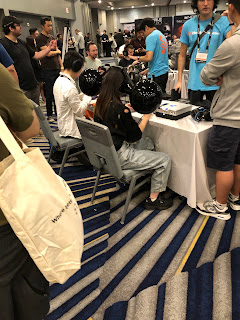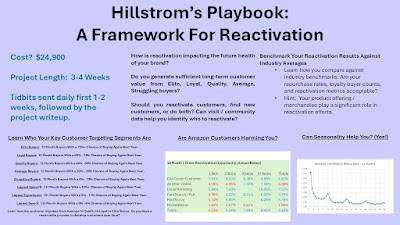I've received a lot of emails and comments in the past week from readers. Most of the feedback follows a handful of themes.
- Service Providers: Orvis might not understand the intangible, unmeasurable value of print.
- Catalog Professionals: This day has been coming for a long time. You should see the internal conversations we've been having the past two years.
Here was one particularly pointed paragraph.
- "I'll believe in you if you name one, just one cataloger who successfully pivoted from print to e-commerce. I await your response."
Now, I have several clients where I am under NDA, and those clients successfully pivoted over the past ten years. I can't go into those cases for obvious reasons.
But I can tell you all about 19 years ago when I worked at Nordstrom and we ended a $160,000,000 catalog business (yeah, that business was bigger than almost all of the businesses that catalog professionals reading this text manage).
The debate about the "catalog" was vibrant and active when I arrived at Nordstrom in January 2001. The merchandise offered in the catalog sold via print ... it was not the fashion-centric product that worked well in stores and online. It should surprise nobody that if you try to grow a catalog brand, you pursue what works in catalogs and not what works in an "omnichannel" environment. It's suicide to sell the same stuff in all channels ... each channel has specific customers with specific preferences, you maximize ROI by catering to the customer who prefers a channel.
By 2003, what "worked" in a catalog was fundamentally different than what worked online, and what worked online was a "cousin" to what worked in stores. Online/Stores were more closely aligned, but catalog merchandise was very different, and it was obvious that merchandise served a different customer. If we tried to align the merchandise in print with stores/online, the catalog failed. If we catered to the catalog customer, the product offering was so different that it didn't really reflect "the brand".
It was obvious something had to be done.
In 2003-2004, we studied the profitability of the catalog channel. We ignored the lousy logic of matchback analytics, instead relying upon A/B holdout tests. We already knew that half of the demand would still exist if we didn't mail catalogs, and we already knew that the organic percentage (50%) was increasing over time. We were left with $160,000,000 in sales (approximately) and $36,000,000 in ad cost. With around 35% of sales flowing through to profit and about $15,000,000 in fixed costs, the catalog generated maybe $5,000,000 in incremental profit ... we assumed the catalog was essentially a break-even proposition.
Which meant the catalog didn't need to exist.
Oh, the internal discussions.
Imagine being the VP of Inventory for the catalog/online division. Inventory professionals don't have mail/holdout results, they just know that if the catalog is mailed you sell 10,000 widgets, they don't get to see how many widgets will be sold if you don't mail a catalog, to them the number is zero. The inventory folks were generally frustrated, and for good reason. They didn't believe the math we published, and I can't blame them for not believing in the math in 2004. In 2024? It's a different world.
I had 24 professionals reporting to me. It became obvious I'd only need 12-15 people if the catalog didn't exist. For one full year, I had to develop a plan for moving forward with a smaller team. The same reality hit inventory management, creative, and our merchandising team.
Merchandising changes were particularly painful, because the retail side of the business was going to "win" and the catalog professionals were going to "lose". Those who stayed would lose power, others would lose their jobs. Not surprisingly, some of the retail folks and online gloated at the expense of the catalog professionals. Humans.
Publicly traded companies do not like to see sales declines. We had to come up with a way to protect the top line. We had $36,000,000 of ad cost that could be reallocated. The online marketing executive and I worked together, and realized a decent chunk of that money could be spent digitally (mostly via non-branded paid search). Eighteen million dollars would be reallocated to search. The rest of the money was reallocated to what I'd loosely call "the retail packaging experience". Yeah, bags. Somehow the paper people always get their money.
We worked for about a year to determine the viability of the catalog - we then spent a year communicating our change in strategy to employees while working to align resources (i.e. downsizing) with the business that remained.
I've had better years, professionally.
I recall one particularly pointed phone call with a trade journalist ... an individual who began the phone call with the phrase "are you the dumbest person in the industry"? The person didn't publish any of my defense ... the trade journalist just ran with the "fact" we were stupid people and didn't understand the value of catalog marketing in an omnichannel world.
We mailed our last catalog two years after initiating discussions about the viability of the catalog.
We had an online + catalog business that generated maybe $400,000,000 in sales. Pull $160,000,000 in catalog sales out, and the online business should have contracted to $240,000,000, then grown by 25% +/- as was the case back in the day, headed back to $300,000,000. The numbers here (outside of the $160,000,000 for catalog) are marginally fuzzy due to memory, but are in the ballpark. I do remember that we ended the year after discontinuing the catalog with a 4% direct-channel sales decrease, meaning we were around $385,000,000 in sales.
In other words, killing the catalog while reallocating money to digital and aligning the merchandise with the retail channel was a very good decision. The online channel began to grow in an unfettered manner, albeit via a different merchandise assortment. This is why you hear me harp about understanding merchandise if you operate with multiple channels generating a significant minority of sales. It's why you hear me plead with you to understand what PLAs do to your business over time, or to understand what Amazon does to your business over time.
The merchandise assortment: About two months after our final catalog mailing, I started receiving phone calls from 60-74 year old women in the Dakotas, in Minnesota, in Michigan, in Vermont, in New Hampshire, in Maine, in Upstate New York, in Idaho. Rural areas. Angry calls. Frustrated calls. These people wanted to know why they were no longer receiving catalogs? They wanted to know what happened to the merchandise they loved, given the merchandise was no longer available on the website. I politely explained over and over and over again that we were no longer mailing catalogs and the products they loved were discontinued. This customer angrily explained over and over and over again why it was a disgrace that we were no longer serving her.
I recall sharing those conversations with my boss. My boss would listen politely, then say "I don't care". I'd respond "How can you not care?". She'd reply "That customer is not our core customer. Our core customer is a 30-50 year old shopper who lives within 25 miles of a store. That's the customer I care about."
Culturally, the composition of the work force changed. Brain drain. The operations executive left. The inventory executive left. The online executive was passed over for promotion to President and left. The President left, replaced by a member of the Nordstrom family. Merchants left. Creative professionals left, some starting their own businesses. My list manager left. My circulation manager left. My forecast manager moved over to the online division. My circulation director moved over to the online division. I didn't have to downsize many people because most saw the writing on the wall and left in advance of the decision.
The brain drain was interesting, because the "brains" that left repeatedly talked about how the business would suffer without their insights and brilliance.
A year later, I walked into the President's office, and told a member of the Nordstrom family that I was proud of him and his team for handling the transition so gracefully. Sales were increasing by 25% per month, profit was at an all-time high, and the people managing the new digital/retail online channel were doing great work. Nobody is as important to a company as they think they are.
Me included.
Eighteen months after the catalog was terminated, my job was greatly "reduced" in scope, in a decision that was clearly made to get me to move on with my life without having to pay severance. I was no longer needed, for obvious reasons. The business was healthy, the people running it were excellent, the job was done.
Since I knew what was coming, I spent my last two years at Nordstrom writing two books, published by the late Don Libey. He showed me how to run a consulting business, and by publishing the books I generated the "community" I needed when I started my business. In early 2006, I began writing this blog ... by March 2007 I had a thousand subscribers. When I announced to readers that I was starting my own business, I had immediate inquiries, and within five days I booked a $40,000 project.
You shouldn't shut down a catalog division without spending about two years preparing the business for the shock that comes without having print. Meeting structures change ... you don't meet because of the August Remail Catalog ... aligning digital activities to support the remail ... you meet because you have to find a way to grow sales in August ... what is the event you'll create to generate sales in August? You prepare ahead of time for the day when your Inventory Executive leaves, or your Chief Merchant leaves, or your CRM Director leaves. Professionally, you prepare ahead of time for what your next job will look like.
I could go on and on, but that wouldn't be a good use of your time.
But yes, I know a little something about somebody who shut down a catalog division successfully. Send me an email (kevinh@minethatdata.com) with your questions, I'll be happy to answer them.
































